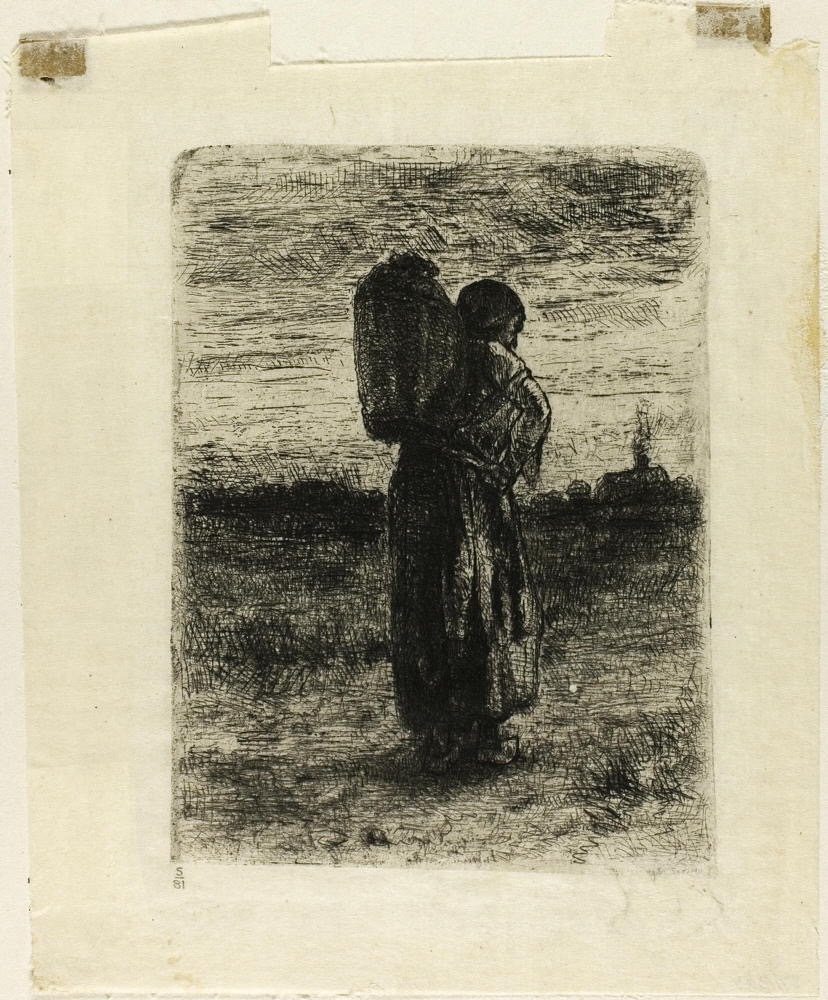MigratingHomeward

Jozef Israëls: Homewards (not dated)
"I am the product of apparently inexorable attraction, destinies manifest."
After 1800, the Swift family's arc shifted westerly. Its second century in the Americas would watch it move into, then through the so-called heartland. If family history was a race, the Swift progeny were to win it, for they would be among the first to see The Eden At The End Of The Oregon Trail. They would have to leave the Eden at the other end of that trail, though, and Grayson County, Virginia, clearly also qualifies as an Eden. Even the area of North Carolina where the Thomas Swift family first settled after traveling down The Great Highway from Maryland still seems Eden-like, it having been the setting of the old Andy Griffith Show's Mayberry, a museum in Andy's honor is located near the old Alamance Battlefield. The forces driving western migration were growing, though. Of course, my interest focused on those who left rather than those who stayed. Those who left became my forebears, while those who stayed behind will forever remain ever more distant aunts and uncles, cousins and hangers-on.
The records turn fuzzier after Flower Swift left Grayson County with his discredited son Thomas, probably first for Kentucky. Some record their departure as somewhere after 1810, but Flower and Mary recorded a son, Elisa, born in Boone County, Kentucky, in seventeen-ninety. This report places Mary there two decades earlier than I'd previously understood. Flower's roaming during The Revolutionary War certainly afforded him opportunities to explore much further West, and his location in Virginia, hard on the Eastern entry to the Cumberland Gap, afforded him access. The records show some Swift half-siblings to his and Mary's offspring, though Mary outlived Flower by a quarter century. History's mostly such mysteries, primarily comprised of threads rather than complete portraits.
Flower and Mary's daughter Martha, born in 1778, took up the next generation's reigns. She married George Currin, later to become a Major after leading a company toward but not quite into the War of 1812. He had come from North Carolina, from a family that had emigrated there from Ireland a generation before. Currin served as a State Representative and Senator in the Virginia Legislature between 1808 and his death in 1818. Martha and George were my fourth great-grandparents. Their son John would become my third. John married his discredited uncle Thomas' daughter Margaret, his first cousin, born in 1819 during the Swift exile in Kentucky. The Currins, heading West after 1840, clearly encountered the Swifts on their way.
The Muse and I visited George Currin's grave when we visited Galax in 2009. His headstone, reportedly carved by his sons, stands as a visual testament to his influence on them. The Currins first sampled Missouri but found it wanting. They'd planned to try Texas next when they happened upon a newspaper story extolling Oregon. They decided to go there instead. Major George's oldest sons, Hugh and George, would become among the earliest to cross the Oregon Trail—in 1843—making it to The Dalles five months after leaving St. Joe. Their mother, Mary Swift Currin, died while preparing for the crossing in the Spring of 1845 and was buried on the Red River in Henry County, Missouri, aged 66. They managed to cross the Barlow Trail over Mt. Hood over the first two weeks of October, battling deep snow and nearly losing their livestock, arriving in what would later become Estacada on the fifteenth of October. They would claim a section at the confluence of Eagle Creek and the Clackamas River and set about creating what they would label Currinville. They would later join the militia responding to the Whitman Massacre, becoming the first in my extended family to enter the Walla Walla Valley in March of 1848. The letters they sent home during that expedition are hair-raising.
My direct forebear, John Currin, crossed the Oregon Trail in 1853, shortly after my second great-grandmother Ann was born. She crossed as an infant. John's wife's mother, Mary Catron Swift, another fourth great, crossed with them at seventy-three, going on to live until 1873, age ninety-three. John and Margaret would thrive in Lane County, Oregon. Ann would marry twice, her second husband Ellsworth (Elza) Van Schoiack, in 1873. They bore my first great-grandmother Clara in 1875, a woman I knew as Grandma Best since she'd changed her name when she married her second husband, Charlie Best, after losing her first, Nathaniel Parker Wallace, to a stroke in 1922.
This brings us almost back to the point of the grand convergence, at least for the Swift-Curren thread. Several others will have to come together to provide the context for my mother's birth and mine. So far in this history, we've only been peering into my mother's forebears. This will continue when I next start poking around into the Seward thread, the one I first mentioned as living in Connecticut in the early sixteen-hundreds, and the Kennistons and the Mayfields. They would head west, too, through several generations, their story different than the Swifts' and Currins', but still trending West. I am the product of apparently inexorable attraction, destinies manifest.
©2024 by David A. Schmaltz - all rights reserved


